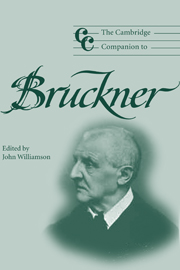Book contents
- Frontmatter
- Part I Background
- Part II Choral music
- Part III The symphonist
- 7 The Brucknerian symphony: an overview
- 8 Bruckner's symphonies – a reinterpretation: the dialectic of darkness and light
- 9 Programme symphony and absolute music
- 10 Bruckner editions: the revolution revisited
- 11 Bruckner and the symphony orchestra
- 12 Between formlessness and formality: aspects of Bruckner's approach to symphonic form
- 13 Formal process as spiritual progress: the symphonic slow movements
- 14 Bruckner and harmony
- Part IV Reception
- Notes
- Select bibliography
- Index
12 - Between formlessness and formality: aspects of Bruckner's approach to symphonic form
from Part III - The symphonist
Published online by Cambridge University Press: 28 September 2011
- Frontmatter
- Part I Background
- Part II Choral music
- Part III The symphonist
- 7 The Brucknerian symphony: an overview
- 8 Bruckner's symphonies – a reinterpretation: the dialectic of darkness and light
- 9 Programme symphony and absolute music
- 10 Bruckner editions: the revolution revisited
- 11 Bruckner and the symphony orchestra
- 12 Between formlessness and formality: aspects of Bruckner's approach to symphonic form
- 13 Formal process as spiritual progress: the symphonic slow movements
- 14 Bruckner and harmony
- Part IV Reception
- Notes
- Select bibliography
- Index
Summary
In memoríam Eugene K.Wolf (1939–2002)
There is something sphinx-like about Bruckner's musical forms. They can seem neat and traditional at one moment, but at the next appear free and unconventional. This duality is evident in the rather disparate interpretations, ranging from the accusation of ‘formlessness’ to the claim that Bruckner's symphonies represent a pinnacle in the evolution of musical form, that have been offered, discussed, and elaborated from the nineteenth century onward.
A prevalent early judgement found Bruckner's music ‘formless’. This concern was first raised after the composer conducted the Second Symphony on 26 October 1873. A. W. Ambros, staking out what was to become a familiar position, wrote that instead of exhibiting, as expected, a ‘firmly joined musical structure [festgefügte musikalische Tektonik]’ the symphony drove the listener to ‘breathlessness’ by presenting a series of ‘tonal shapes [Tongebilde] wilfully strung one after another’. Throughout the 1880s the notion that Bruckner's symphonies were chaotic in form percolated through antagonistic reviews, most importantly in those by Hanslick, Kalbeck, and Gustav Dömpke. Dömpke, for example, opened his review of the Viennese premiére of the Seventh Symphony with the assertion ‘Bruckner lacks the feel for the primary elements of musical formal shape, for the coherence of a series of melodic and harmonic component parts.’ Even observers sympathetic to Bruckner's music were occasionally puzzled by his forms; Hugo Wolf referred to a certain ‘formlessness’ that haunted the symphonies despite their ‘originality, grandeur, power, imagination and invention’.
- Type
- Chapter
- Information
- The Cambridge Companion to Bruckner , pp. 170 - 189Publisher: Cambridge University PressPrint publication year: 2004
- 4
- Cited by



